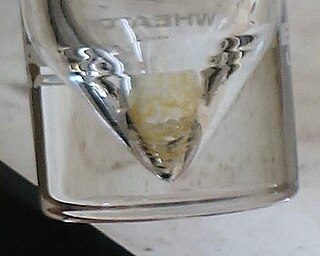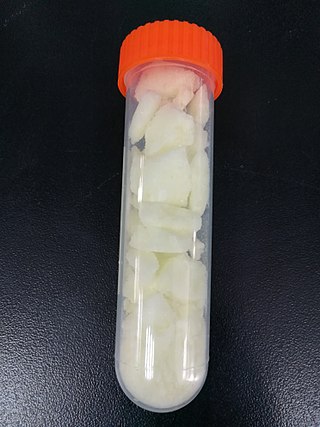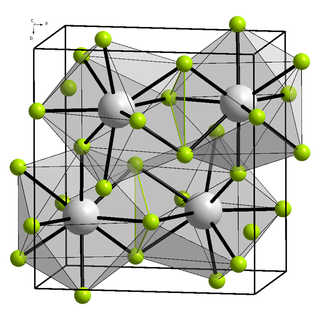Related Research Articles

Curium hydroxideCm(OH)3 is a radioactive compound first discovered in measurable quantities in 1947. It is composed of a single curium atom and three hydroxy groups. It was the first curium compound ever isolated.

Curium(III) fluoride or curium trifluoride is the chemical compound composed of curium and fluorine with the formula CmF3. It is a white, nearly insoluble salt that has the same crystal structure as LaF3. It precipitates as a hydrate when fluoride ions are added to a weakly acidic Cm(III) solution; alternatively it can be synthesized by reacting hydrofluoric acid with Cm(OH)3. The anhydrous form is then obtained by desiccation or by treatment with hydrogen fluoride gas.

Einsteinium(III) chloride is a chloride of einsteinium.

Dysprosium(III) nitrate is an inorganic compound, a salt of dysprosium and nitric acid with the chemical formula Dy(NO3)3. The compound forms yellowish crystals, dissolves in water, forms a crystalline hydrate.

Ytterbium(III) nitrate is an inorganic compound, a salt of ytterbium and nitric acid with the chemical formula Yb(NO3)3. The compound forms colorless crystals, dissolves in water, and also forms crystalline hydrates.
Polonium sulfide is an inorganic compound of polonium and sulfur with the chemical formula PoS. The compound is radioactive and forms black crystals.
Polonium tetraiodide is a binary inorganic compound of polonium and iodine with the chemical formula PoI
4. The compound forms volatile black crystals.

Yttrium perchlorate is the inorganic compound with the chemical formula Y(ClO
4)
3. The compound is an yttrium salt of perchloric acid.

Dysprosium(III) iodide is a binary inorganic compound of dysprosium and iodine with the chemical formula DyI
3.

Californium(III) fluoride is a binary inorganic compound of californium and fluorine with the formula CfF
3
Californium(III) oxide is a binary inorganic compound of californium and oxygen with the formula Cf
2O
3. It is one of the first obtained solid compounds of californium, synthesized in 1958.
Iridium(IV) iodide is a binary chemical compound of iridium and iodide with the chemical formula IrI
4.

Curium(IV) fluoride is an inorganic chemical compound of curium and fluorine with the chemical formula CmF4.
Sodium hexafluorotitanate is an inorganic compound of sodium, fluorine, and titanium with the chemical formula Na2TiF6.
Potassium hexafluorotitanate is an inorganic compound of potassium, fluorine, and titanium with the chemical formula K2TiF6.
Ammonium hexafluorozirconate is a complex inorganic compound of nitrogen, hydrogen, fluorine, and zirconium with the chemical formula (NH4)2ZrF6.
Neptunium(III) phosphide is a binary inorganic compound of neptunium metal and phosphorus with the chemical formula NpP.
Zirconium monophosphide is a binary inorganic compound of zirconium metal and phosphorus with the chemical formula ZrP.
Zirconium diphosphide is a binary inorganic compound of zirconium metal and phosphorus with the chemical formula ZrP2.
Diruthenium phosphide is a binary inorganic compound of ruthenium metal and phosphorus with the chemical formula Ru2P.
References
- ↑ Macintyre, Jane E. (23 July 1992). Dictionary of Inorganic Compounds. CRC Press. p. 3671. ISBN 978-0-412-30120-9 . Retrieved 5 March 2024.
- ↑ Isotopic Power Sources ...: A Compendium : Property and Processes Review. Martin Nuclear Division. 1961. p. 2-170. Retrieved 19 March 2024.
- ↑ Morss, L. R.; Edelstein, Norman M.; Fuger, Jean (31 December 2007). The Chemistry of the Actinide and Transactinide Elements (3rd ed., Volumes 1-5). Springer Science & Business Media. p. 743. ISBN 978-1-4020-3598-2 . Retrieved 19 March 2024.
- ↑ Koch, Günter (5 October 2013). Transurane: Teil C: Die Verbindungen (in German). Springer-Verlag. p. 249. ISBN 978-3-662-11547-3 . Retrieved 19 March 2024.
- ↑ Macintyre, Jane E. (23 July 1992). Dictionary of Inorganic Compounds. CRC Press. p. 3671. ISBN 978-0-412-30120-9 . Retrieved 19 March 2024.